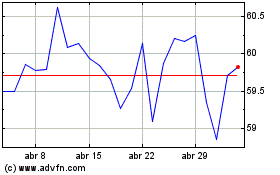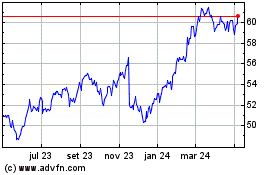By Esther Fung
With the booming growth of online grocery sales and rising
consumer demand for fresh produce, property investors are trying to
cash in on the places where grocers and delivery companies store
all their food.
Customers of these cold storage warehouses are some of the
biggest names in the food business, from manufacturers like Tysons
Food Inc. to grocery chains such as Kroger Co. and big food sellers
like Walmart Inc. Online grocers like Peapod also use
temperature-controlled spaces.
Now--similar to the way real-estate investors flocked to
distribution centers to profit from the rise of online
shopping--investors are starting to pile into cold storage
warehouses. Analysts say it is a business poised for rapid growth
but one that involves more risks than owning other real estate,
including typical industrial warehouses that hold books, mobile
phones or sweaters.
During the first three quarters this year, investors bought $1.9
billion worth of refrigerated warehouses--up from $1.77 billion for
all of 2018--and higher than any year in the past decade, according
to data firm Real Capital Analytics.
While there are hundreds of companies that own refrigerated
warehouses in the U.S., the sector is consolidating as the biggest
players buy up smaller competitors. Just two firms--Lineage
Logistics LLC and Americold Realty Trust--control 63% of the cold
storage warehouses held by the top 25 owners in North America,
according to the International Association of Refrigerated
Warehouses.
Last month, Americold said it would acquire Canada-based Nova
Cold Logistics, which owns three locations, for 337 million
Canadian dollars ($253 million). It also completed the purchase of
two facilities in Maryland and Pennsylvania.
Shares of Americold, the only publicly-listed real-estate
investment trust focused on cold storage, have been on a tear. The
stock's total returns are up 46% this year, compared to the broader
MSCI U.S. Reit Index, which rose 26%.
Having a big portfolio shields the firm from fluctuations in the
agriculture or seafood businesses, said Fred Boehler, chief
executive officer of Americold.
"Whether there is a bad harvest or cattle shortages, we as
consumers, are still going to eat," he said. "If beef is down,
you're going to eat chicken or pork."
The push for more cold storage is also going global. Lineage,
the world's largest refrigerated storage company by storage
capacity, last month said it said it would pay more than $900
million to acquire Emergent Cold in a move to expand in Asia.
Lineage bought rival Preferred Freezer Services LLC for more than
$1 billion earlier this year.
"Cold-storage used to be a cottage industry where a company
would own three or four buildings," said Greg Lehmkul, Lineage's
CEO, in an interview with The Wall Street Journal last month.
Despite shifting consumer tastes toward fresher foods and
delivery convenience, the business of storing food comes with
plenty of risks that owners of distribution centers for
non-perishables don't face.
In the 1990s, real-estate companies like Vornado Realty Trust
and Crescent Real Estate Equities Co. suffered from
greater-than-expected capital and labor costs associated with cold
storage and exited the business in the 2000s.
Operators of cold storage facilities generally have to hire more
staff to manage the facilities and handle services like packing and
unpacking food for distribution.
Americold experienced an increase in health care claims related
to health care claims from employees, which reached $13 million in
the third quarter. Analysts from SunTrust Robinson Humphrey have
said they would have to "think more cautiously about longer-term
labor expense estimates," at Americold following its latest
earnings report.
This resulted in a reduced guidance of its annual net operating
income growth to the "bottom half" of a 3% to 6% estimate.
The company said investors should focus on annual rather than
quarterly results, which can be bumpy.
Cold-storage warehouses can also cost three times more to build
than those for dry goods, according to real-estate firm CBRE Group
Inc. The facilities have freezing and preservation equipment.
Operators often require specialized knowledge about food
distribution and storage. Some foods need to be frozen gradually
and operators have to prevent temperatures from fluctuating too
much when doors are opened.
When you leave your refrigerator door at home open for too long,
the temperature could rise by 5 degrees. "We can't allow that to
happen," said Mr. Boehler, adding that his facilities have "high
speed doors."
Still, returns for cold storage have been outperforming those of
dry warehouses, as indicated by capitalization rates, a measure of
a property's annual income as a percentage of its price. Lower cap
rates means higher values, and the gap between cold-storage and
dry-storage warehouses have narrowed to 0.75 percentage point from
2 percentage points over the past three years, CBRE said.
Jennifer Smith contributed to this article.
Write to Esther Fung at esther.fung@wsj.com
(END) Dow Jones Newswires
December 10, 2019 07:14 ET (12:14 GMT)
Copyright (c) 2019 Dow Jones & Company, Inc.
Walmart (NYSE:WMT)
Gráfico Histórico do Ativo
De Mar 2024 até Abr 2024

Walmart (NYSE:WMT)
Gráfico Histórico do Ativo
De Abr 2023 até Abr 2024
